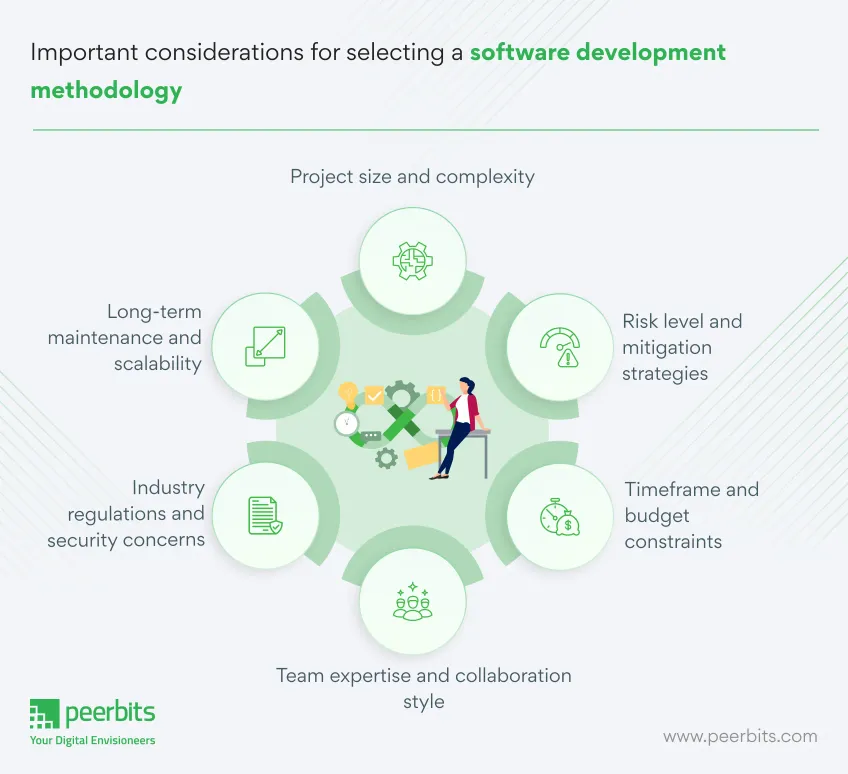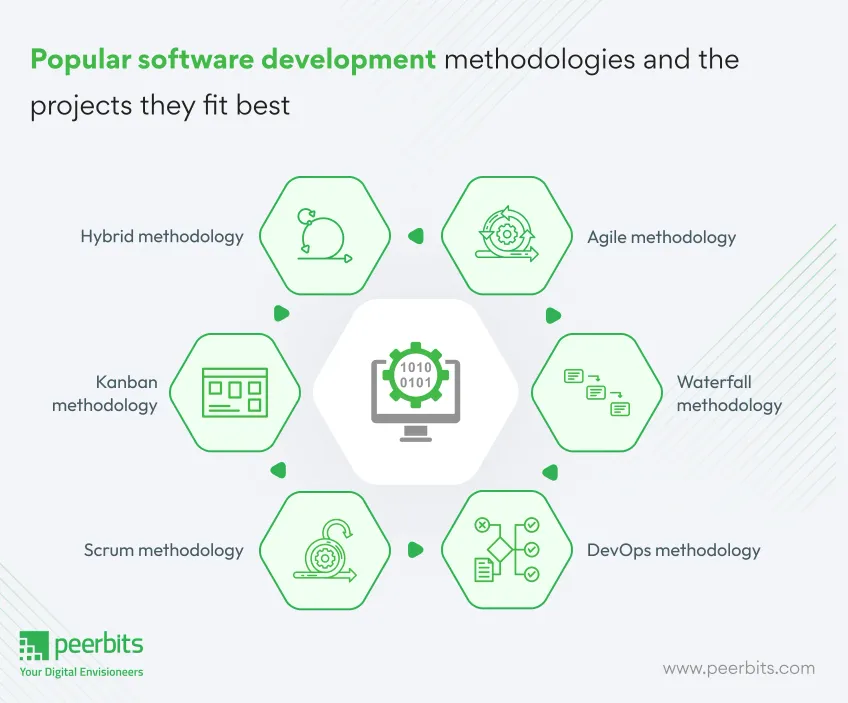Software development methodologies define how projects are structured and executed. Popular methods like Agile, Waterfall, and DevOps each have their own strengths, catering to different project needs. Selecting the right software development methodology is critical as it directly influences project success, timelines, and budget.
Choosing the wrong methodology can lead to delays, poor collaboration, and unmet expectations. Businesses often face challenges in communicating with software development services sharing incorrect project scope, failing to consider scalability, or selecting a method that doesn’t fit the project’s needs.
This blog will help you understand these challenges and guide you toward choosing the best methodology for your software development project.
Why selecting the right software development methodology is critical?
Selecting the right software development methodology is essential for the success of any project. It impacts how teams work, the efficiency of the process, and the outcome. A suitable methodology ensures that the project aligns with business objectives and adapts to changing needs. Below are the key reasons why it’s critical to make the right choice.
1. Alignment with project goals and business objectives
A well-chosen methodology ensures the development process aligns with both project goals and business priorities. It provides clear direction, helping the team stay focused on achieving specific outcomes. This alignment improves project efficiency and ensures the product meets the intended purpose.
The right methodology also makes it easier to track progress and success. Teams can ensure the project supports broader business objectives and delivers real value by setting structured milestones and goals.
2. Enhancing efficiency and productivity
The right methodology streamlines workflows and minimizes redundancy, which enhances productivity. It organizes tasks, reduces confusion, and helps allocate resources effectively, leading to faster development and quicker time-to-market.
Clear processes also improve team collaboration and let members focus on what matters most. This increased efficiency results in a more productive development cycle and a better return on investment for the business.
3. Ensuring quality control and meeting compliance standards
Choosing the right methodology helps maintain high-quality standards. It ensures consistent testing and quality checks throughout the development lifecycle, reducing the likelihood of defects.
It also simplifies compliance. For industries with strict regulations, a suitable methodology integrates necessary compliance processes, minimizing the risk of legal issues and ensuring the product meets industry-specific standards.
4. Flexibility and adaptability for changing requirements
A good methodology offers the flexibility to adapt to changing project requirements. Agile methodologies allow for iterative development, making it easier to adjust to shifting market conditions and customer demands.
This flexibility ensures the project stays relevant and can be updated or changed without derailing progress. It helps teams deliver a final product that meets evolving business needs.
5. Risk management and cost optimization
Effective risk management is another benefit of selecting the right methodology. By identifying potential risks early, teams can proactively address them and keep the project on track.
Cost optimization also improves as resources are allocated efficiently. A structured methodology prevents unnecessary delays and spending, ensuring the project remains within budget while still delivering quality results.

Understanding your project requirements
To choose the right software development methodology, it’s essential to have a clear understanding of your project requirements. This involves defining clear goals, identifying constraints, evaluating the project’s complexity, and understanding stakeholder expectations.
Addressing these factors will ensure the methodology you choose is best suited to meet the project's needs.
1. Defining project goals and objectives
Start by clearly defining what the project aims to achieve. Establish measurable goals that align with your business needs. Whether the goal is to launch a new product or improve an existing system, the chosen methodology should support these objectives. This clarity helps in setting a clear path for the development process and ensures that all team members are aligned towards a common goal.
Clear goals also help in determining the scope and timeline of the project. A well-defined objective lets teams focus on key deliverables and ensures the project stays on track throughout the development lifecycle.
2. Identifying project constraints
Understanding the constraints of the project is essential for selecting the right methodology. Consider budget limitations, time constraints, available resources, and any regulatory requirements that need to be met. If the project has a tight deadline or limited budget, methodologies like Agile, with its focus on iterative development, may be more suitable.
Regulatory requirements are another important constraint. Certain industries, such as healthcare or finance, require strict adherence to compliance standards. The methodology chosen must integrate processes that meet these standards and avoid costly legal or regulatory issues.
3. Evaluating project complexity and scalability needs
Projects vary in complexity, and selecting a methodology that can handle the scale and complexity of the project is critical. Simple projects with well-defined requirements may benefit from a more structured methodology like Waterfall, while complex, dynamic projects may require the flexibility of Agile or DevOps for enterprises.
Scalability is another factor to consider. If the project needs to scale quickly or handle increasing user demands, the methodology should support this growth. Ensure that the chosen methodology accommodates future scalability requirements to prevent rework as the project evolves.
4. Assessing stakeholder expectations and market demands
Understanding stakeholder expectations is key to selecting the right methodology. Stakeholders have different priorities, such as speed, quality, or cost. By engaging with them early on and defining their expectations, you can better understand which methodology will satisfy their needs.
Market demands also play a significant role. If the market requires a product to be launched quickly or needs continuous updates, a flexible methodology like Agile will be advantageous. Balancing stakeholder’s needs with market demands helps to determine the best approach for timely and efficient product delivery.
Key factors businesses must consider before choosing a methodology
Choosing the right software development methodology is an important decision for businesses. It not only affects how a project is managed but also influences the final product’s quality, timeline, and cost. Before making this choice, businesses must evaluate several key factors to ensure the methodology aligns with the project’s unique needs and constraints.

1. Project size and complexity
The size and complexity of a project play an important role in selecting the right methodology. Large projects with multiple components may require a more structured and detailed approach, like Waterfall, to ensure that every phase is completed before moving on to the next.
For smaller projects or those with rapidly changing requirements, a flexible methodology like Agile might be more appropriate.
Complex projects involving diverse teams, multiple integrations, or high levels of uncertainty benefit from iterative approaches. These lets teams break down the project into smaller, manageable pieces while constantly refining the product based on feedback.
2. Risk level and mitigation strategies
Risk is inherent in all software development projects, but the level of risk varies based on the project’s scope and goals. Projects with high uncertainty or those that involve new technologies require methodologies that emphasize frequent testing and feedback, such as Agile development process or DevOps.
These allow teams to identify issues early and adjust the development process accordingly.
In contrast, projects with low risk and clear, well-defined requirements can benefit from more traditional methodologies like Waterfall, where each phase follows a predetermined path. Understanding risk levels helps businesses choose a methodology that mitigates potential setbacks and keeps the project on track.
3. Timeframe and budget constraints
Projects with tight timeframes or limited budgets require efficient use of resources. Some methodologies, like Agile, prioritize delivering smaller features in short cycles, which can help meet deadlines while maintaining flexibility.
This ensures that the most important features are prioritized and delivered on time.
On the other hand, methodologies like Waterfall require more upfront planning, which can be helpful when there’s a fixed budget and timeline. If the project scope is well-defined from the start, Waterfall can provide a predictable cost structure, making it easier to manage expenses.
4. Team expertise and collaboration style
The development team's expertise and collaboration style significantly influence the methodology choice. Teams with experience in Agile or DevOps are better equipped to manage rapid changes, frequent releases, and continuous integration.
These methodologies focus on collaboration, flexibility, and fast feedback loops.
If the team is more accustomed to structured, linear workflows and prefers clear roles and responsibilities, methodologies like Waterfall may be more effective. Understanding the team's preferred working style can help select a methodology that fits their strengths, ensuring smoother execution.
5. Industry regulations and security concerns
Some industries, such as healthcare, finance, or government, are subject to strict regulations and security standards. For projects in these sectors, choosing a methodology that supports compliance and thorough documentation is essential.
Waterfall, with its sequential nature and focus on detailed planning, can be ideal for projects where adherence to standards is critical.
Methodologies like Agile, while flexible, can be adapted to meet these needs if proper security protocols and documentation procedures are incorporated. It is crucial to understand the regulatory environment the project operates in to select a methodology that supports compliance without compromising on flexibility.
6. Long-term maintenance and scalability
Long-term maintenance and scalability are crucial factors, especially for large or complex projects. The chosen methodology should support easy updates, scaling, and maintenance after the project’s initial release.
Agile methodologies, with their iterative development and continuous feedback, are often more adaptable for scaling and ongoing maintenance.
For projects requiring long-term support or growth, the methodology should incorporate processes for regular updates and improvements. If a project is expected to undergo frequent changes or need continuous improvements, a flexible plan will ensure it can evolve with the business’s growing needs.
Top software development methodologies and when to use them
Choosing the right methodology depends on the project’s specific needs, scale, and goals. Below are some popular methodologies, each suited to different types of projects:

1. Agile methodology
- Key principles: Iterative development, flexibility, collaboration
- Benefits: Faster releases, adaptability to changes, client involvement
- Best suited for: Startups, SaaS products, customer-driven applications
Agile is a flexible, iterative approach where development occurs in small cycles (sprints), allowing teams to respond quickly to changing requirements. It encourages active collaboration with clients, ensuring their input is integrated throughout the process, making it ideal for projects with evolving requirements.
2. Waterfall methodology
- Key principles: Sequential phases, clear documentation, upfront planning
- Benefits: Predictability, strong documentation, easier compliance
- Best suited for: Enterprise applications, government projects, financial software
Waterfall follows a strict linear path, where each phase must be completed before moving to the next. This methodology is suitable for projects with clear, unchanging requirements and works well for highly regulated industries that require thorough documentation and clear milestones.
3. DevOps methodology
- Key principles: Collaboration between development & operations, automation, monitoring
- Benefits: Faster time-to-market, reliability, scalability
- Best suited for: Cloud-based applications, SaaS, large-scale enterprise solutions
DevOps focuses on creating a culture of collaboration between development and operations teams, integrating automated testing and deployment. It is ideal for continuous delivery environments, where fast, reliable updates and scalability are key to project success.
4. Scrum methodology
- Key principles: Sprints, daily standups, cross-functional teams
- Benefits: Quick iterations, enhanced collaboration, faster delivery
- Best suited for: Mid-sized software projects, MVP development, AI-driven applications
Scrum is a subset of Agile that focuses on delivering functional product increments through short development cycles (sprints). It enhances team collaboration through daily standups and fosters faster delivery of product features. It's great for projects where frequent client feedback is critical.
5. Kanban methodology
- Key principles: Visual boards, continuous delivery, workload balance
- Benefits: Reduces bottlenecks, improves efficiency, enhances transparency
- Best suited for: Support & maintenance projects, evolving product roadmaps
Kanban uses visual boards to manage workflow and track tasks in real-time. This methodology is ideal for projects that require continuous improvements, ongoing maintenance, or the management of evolving product features, helping teams stay focused and efficient.
6. Hybrid methodology
- When to use: Combining Agile & Waterfall for structured yet flexible workflows
- Benefits: Balances predictability and adaptability
- Best suited for: Large enterprise projects, regulated industries, mission-critical systems
Hybrid methodologies combine the strengths of Agile and Waterfall, creating a balance. This is particularly useful for large-scale or highly regulated projects where some elements benefit from the structured, predictable approach of Waterfall, while others can be more flexible, like Agile.
Read more: Agile vs Scrum vs Kanban: What’s the difference? Complete guide
Common mistakes businesses make when selecting methodologies
When selecting a software development methodology, businesses often make several key mistakes that can impact project success.
Here are some common pitfalls along with solutions to help avoid them:
1. Ignoring project requirements and choosing based on trends
Many businesses select a methodology based on its popularity, such as Agile or DevOps, without considering whether it fits their project’s unique needs.
Solution: Prioritize a methodology that directly addresses your project’s requirements, size, and complexity. Take time to evaluate the specific needs of your project, including its scope, resources, and timeline, before choosing a methodology.
2. Failing to involve stakeholders in decision-making
Businesses often overlook the importance of involving key stakeholders—such as clients, managers, and team members—when selecting a methodology.
Solution: Engage stakeholders early in the decision-making process. Gather feedback to ensure the chosen methodology aligns with business goals and expectations. Regular communication will help address concerns and create a sense of ownership among stakeholders.
3. Overlooking long-term maintenance and scalability needs
Some businesses select methodologies without considering the long-term maintenance and scalability of the project. This can lead to difficulties once the project is in production.
Solution: Factor in how the methodology will support ongoing updates, future scaling, and maintenance. Ensure the selected methodology can accommodate future requirements, including handling additional features, performance enhancements, and regulatory changes.
4. Misjudging team expertise and available resources
A common mistake is selecting a methodology that requires skills or tools that the team lacks.
Solution: Assess your software development team’s expertise and available resources before choosing a methodology. Consider providing training or hiring experts if necessary. Match the methodology with the team's capabilities to ensure smooth implementation and avoid delays.
Conclusion
Selecting the right software development methodology plays a significant role in a project's success. Understanding project requirements, aligning the methodology with business objectives, and considering factors like scalability, team expertise, and long-term maintenance help in making an informed choice.
Stakeholder involvement ensures that the selected methodology supports business goals while addressing potential risks. Flexibility in approach allows businesses to adapt to changing project needs. Evaluating all aspects before making a decision helps in avoiding common mistakes and choosing a methodology that leads to efficient development and successful project completion.









